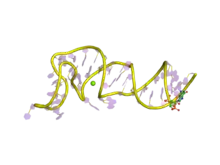Coronavirus 3′ stem-loop II-like motif (s2m)
The Coronavirus 3′ stem-loop II-like motif (also known as s2m) is a secondary structure motif identified in the 3′ untranslated region (3′UTR) of astrovirus, coronavirus and equine rhinovirus genomes.[1][2] Its function is unknown, but various viral 3′ UTR regions have been found to play roles in viral replication and packaging.
| Coronavirus 3′ stem-loop II-like motif (s2m) | |
|---|---|
 Predicted secondary structure and sequence conservation of s2m | |
| Identifiers | |
| Symbol | s2m |
| Rfam | RF00164 |
| Other data | |
| RNA type | Cis-reg |
| Domain(s) | Eukaryota; Viruses |
| SO | SO:0000233 |
| PDB structures | PDBe |
This motif appears to be conserved in both nucleotide sequence and secondary structure folding indicating a strong evolutionary selection for its conservation. The presence of this conserved motif in these three different viral families is suggested to be the result of at least two separate recombination events.[2]
Other RNA families identified in the coronavirus include the SL-III cis-acting replication element (CRE), the coronavirus frameshifting stimulation element, the coronavirus packaging signal and the coronavirus 3′ UTR pseudoknot.

Biological significance
Functionally during host invasion by viral RNA, it appears that s2m first binds one or more proteins as a mechanism for the viral RNA to substitute host protein synthesis. This has also been seen in s2m RNA macromolecular substitution of ribosomal RNA folds. The s2m RNA element are also effective targets for the design of anti-viral drugs.[3][4] During COVID-19 pandemic in 2020, many genomic sequences of Australian SARS‐CoV‐2 isolates have deletions or mutations in the s2m, suggesting that RNA recombination events may have occurred in this RNA element of SARS-CoV-2.[5]
See also
References
- Jonassen CM, Jonassen TO, Grinde B (1998). "A common RNA motif in the 3′ end of the genomes of astroviruses, avian infectious bronchitis virus and an equine rhinovirus". Journal of General Virology. 79 (4): 715–718. doi:10.1099/0022-1317-79-4-715. PMID 9568965.
- Robertson MP, Igel H, Baertsch R, Haussler D, Ares M, Scott WG (2005). "The structure of a rigorously conserved RNA element within the SARS virus genome". PLOS Biology. 3 (1): e5. doi:10.1371/journal.pbio.0030005. PMC 539059. PMID 15630477.
- Robertson MP, Igel H, Baertsch R, Haussler D, Ares M (2005). "Jr, et al. (2005) The Structure of a Rigorously Conserved RNA Element within the SARS Virus Genome". PLOS Biology. 3 (1): e5. doi:10.1371/journal.pbio.0030005. PMC 539059. PMID 15630477.
- Robertson MP, Igel H, Baertsch R, Haussler D, Ares M, Scott WG (January 2005). "The Structure of a Rigorously Conserved RNA Element within the SARS Virus Genome". PLOS Biology. 3: e5. doi:10.1371/journal.pbio.0030005. PMC 539059. PMID 15630477. Retrieved 2013-06-04.
- Yeh TY, Contreras GP (2020). "Emerging viral mutants in Australia suggest RNA recombination event in the SARS‐CoV‐2 genome". Medical Jornal of Australia. 213 (1): 44–44.e1. doi:10.5694/mja2.50657. PMC 7300921. PMID 32506536.